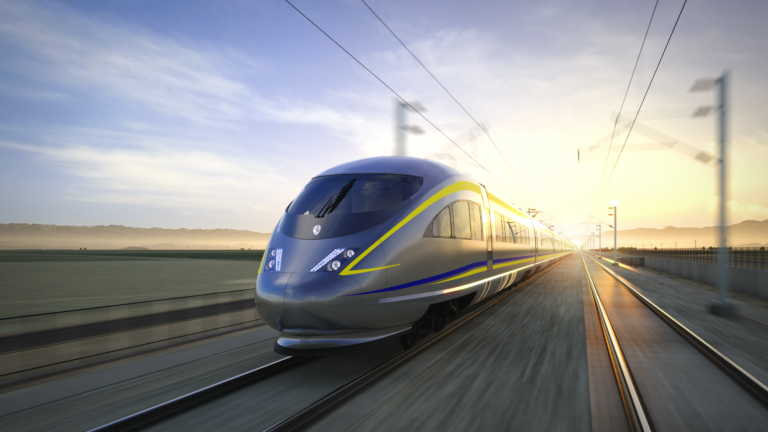
SAM QUATTROCIOCCHI – 26 JANUARY 2023
EDITOR: GRIFFIN SHUFELDT
Election night 2008 — as President Obama won a historic election with a sweeping mandate for progressive change, California voters approved a state ballot measure which would begin work on the state’s own transformative project. Since the 1990s, California took control of its intrastate Amtrak routes and has been investing in building out its rail infrastructure. Proposition 1A would continue this effort by approving the construction of a High Speed Rail line from San Francisco to Los Angeles, finally connecting the state’s northern and southern metro areas with a state-of-the-art, fast, convenient, and environmentally sustainable transit option that would serve as the backbone of California’s expanded transit system. The measure passed with 52.62% voting in favor to 47.38% against. But, this was only the beginning of a saga the state still finds itself in the middle of. It is a story of colliding political agendas and even attempted sabotage by a billionaire with a vendetta against public transit. Building America’s first proper high speed rail system was never going to be easy; especially when the project is so ambitious that it could become one of the most advanced in the world. As such, this project has encountered various political and economic headwinds. The level of scrutiny, hit-pieces, and negative press has been ridiculously overwhelming to the point that it is almost common knowledge that the project is a bloated failure that has cost too much money and will probably never even begin service.
This image of the project is overly pessimistic and myopic. California’s High Speed Rail remains a good project which will add enormous value to the state and serve as a launch-pad for future projects across the country. The criticisms of the project have been mostly centered around two separate but related categories. Firstly, the design of the project. Secondly, its cost. Fair criticisms in both of these categories certainly exist. But, they have been overstated to the point where they’re presented as if they make the entire project a failure. In reality, obstacles aside, California’s Bullet Train is poised for success. Once it is complete and being used, the initial problems will fade into the rearview mirror, just as they have with similar projects around the world that are now looked at as beacons of rail success.
Early in the project, there was debate over which route to choose for the line. This was the beginning of the dramatic debates around this project. The disagreement was over a central tradeoff. Either the project would stop directly at cities in the central valley on the way north or south, sacrificing time, and adding cost, but also increasing ridership, or it would run directly parallel to the I-5 freeway, accessing those central valley cities via bus connections and saving cost. Eventually, the CAHSR authority opted for the former. The train would follow a slightly longer path between the north and south metro areas by stopping directly at several central valley cities, the path to and from the LA station was also made longer by including a dogleg turn into the Mojave to stop at Palmdale.
This decision has been the focus of lots of criticism of the project. Commentators chalk these decisions up to local politicians pursuing their personal agenda at the expense of the project’s strength. They argue that the detour needlessly adds cost and makes the project overly complicated. A less direct route also makes it more important to maintain a high speed in order to stay within the mandated 2 hour and 40 minute travel time requirement. The route they picked would require the train to achieve an average speed of 164 mph, making adherence to a 220 mph track speed even more vital. For context, the Japanese Shinkansen has an average speed of 145 mph, and the French TGV’s is 121 mph. So due to the path the train will take, the project really does need to be state-of-the-art.
The decision to begin construction on the central valley segment between Bakersfield and Madera has also come under a lot of fire. Some argued that the project should begin with developments for the Bay Area and Los Angeles rail, which could be connected in the future as ridership increased. Ultimately, the authority went forward with a plan where the central valley would be constructed first, since it is the simplest and easiest segment to build due to its open and flat geography. Many have attacked this decision as effectively making the project an expensive “train to nowhere.” Critics are skeptical that the project will succeed in creating a HSR corridor from LA to San Francisco, and think the central valley segment is therefore a money pit. These are just some of the many criticisms of the HSR design. But, they virtually all critique the project as being overly ambitious and inefficiently designed.
All of this, they charge, has ballooned the cost of the project beyond what was attainable. Thus is their second focus: high costs. The project has increased from an initial $33 billion price tag to more than double that at $113 billion. They say the cost being so high is evidence of severe mismanagement and that we have to cut off the funding tap now before we sink evermore cash into the project. This is especially relevant, they say, because the project still has a major obstacle ahead of it, literally. Mountains. The authority started with the central valley, partially because it really is the low-hanging fruit. To connect it to LA or San Francisco, the project will have to dig tunnels through mountains. This is an extremely expensive task, especially for a country like ours, which is notorious for being unable to build anything cost effectively. This focus on the cost of the project also reflects in an obsession with profitability once the service is functional. Many critics are skeptical of whether the train can be profitable given the design of the system.
These issues with the project are a diverse mix of reasonable and unreasonable criticisms. To start, the notion that it would’ve been a better choice to save costs and time by building the corridor parallel to the I-5 freeway alignment is misguided and defeats the purpose of the project. Yes, CAHSR does intend to connect the northern and southern metro areas of California; but, it also aims to be a backbone which connects the entire state to an expanded transit network. An I-5 aligned train would need cumbersome bus connections to reach the growing cities in the central valley or Palmdale in the south. Stopping directly at those cities may be costly, but it also increases ridership and provides a fantastic opportunity to grow and enrich those communities by better connecting them to the rest of the state. This is a game of trade-offs. Many commentators attempt to reduce these decisions to cronyism on the part of local politicians. To be sure, there have been political games played over how to shape the project, but that’s not surprising given what is at stake. This rail line presents a historic opportunity for California and its constituent communities. Naturally, local representatives want their cities to benefit from it. Every benefit of this project, from economic gains to environmental preservation, would benefit from more directly connecting to these locales.
If we take the goal of building a High Speed Rail service from San Francisco to Los Angeles seriously, it only makes sense to begin with the low-hanging fruit and build the central valley portion first. It gets built infrastructure on the map, which only makes sense if the system will eventually be completed. Doing it first gives a strong incentive to complete the project and link it to the northern and southern segments, rather than have a wasted partial high speed rail system in the middle of nowhere. Starting in the Central Valley just makes it far harder to cancel the project. For those of us who want to see California lead the way with America’s first proper high speed rail system, this is an asset, not a flaw.
With that said, the project is already providing benefits to the northern and southern metro areas, which will eventually be linked by the train. A little known initiative of the California HSR Authority is the electrification of Caltrain. The high speed train will share track with Caltrain for the portion in the Bay Area. This both saves costs and provides a great opportunity to modernize the out-of-date rail infrastructure in the area well before High Speed Rail is finished. The tradeoff, however, is that once HSR is completed, it will only be able to travel at a reduced (but still fast) speed on Caltrain’s tracks. To prepare Caltrain infrastructure to eventually share tracks with HSR, California is in the process of upgrading Caltrain to brand new 125 mph pantograph-electrified train sets. The Bay Area will see the benefits of this project even before the rest of the system is completed.
What is a valid concern is trip time. The choices that have resulted in a longer route and slower speeds in some portions have also reduced the margin for error when it comes to achieving the 2 hour and 40-minute trip time. It will add to costs for the system to have to maintain top-of-the-line 220 mph speeds in order to keep travel time low. This is on top of the issue that Los Angeles to San Francisco is already at the upper limit of distance where rail can compete with air travel. Running express trains which bypass certain intermediate stops in order to keep SF-LA travel time low can help with this, but the future of travel time remains somewhat uncertain, with highly generous computer models only predicting a ~3 minute margin for error. This is not a terminal issue for the project, nor will it somehow negate its enormous benefits if it comes to pass. But, it is absolutely a trade-off worth keeping tabs on as the project develops.
Pivoting back to worries about the project’s cost, let’s look at arguably the most famous high speed rail system in the world: Japan’s Shinkansen. Japan’s first operating segment of this system had many similarities to California’s prospective system. It faced political difficulties, funding roadblocks, and ultimately cost double its allotted budget (sound familiar?). Now, nobody remembers this. The initial cost is not remembered compared to the intangible and probably incomprehensible value Japan’s trains provide to its economy and communities. As long as this project is finished, it will provide enormous benefits to the state and be seen as a monument to what is possible in an America that takes climate change seriously.
Canceling the project is not a serious option. It would be a true waste of money and opportunity. It would also, as alluded to earlier, be incredibly embarrassing to have finished, but unused HSR viaducts just sitting there in the central valley. But, that is not to say that costs aren’t an issue at all. The project has been quite expensive and will continue to be. Acquiring all the land from LA to the Bay Area was an expensive slog, construction has proceeded slowly, and most tasks have been delegated to expensive contractors. The best way to decrease the cost of this project, now, is to fully fund it and finish it as fast as possible. The longer it goes on, the more painful and expensive it will be. In the long run, increasing the state’s first-hand productive capacity or sticking with a primary manufacturer will make projects like this cheaper to undertake. These changes will get easier to enact as high speed rail and other transit projects are more prioritized and happen more frequently. The only way out is through, especially when this is a necessary technology and transportation option for a sustainable future. Lowering costs is necessary, but none of these costs are anything close to the hidden costs of not building infrastructure like this. Unchecked climate change is the ultimate cost we need to avoid. This is not even taking into account the fact that there is evidence building the system will be cheaper than expanding highway and air infrastructure to accommodate future travel demand. We are lucky enough to have a tremendous opportunity to do this given California’s historic annual budget surplus. Let’s do it.
Related to the concerns about price are concerns about profit. Many detractors point to how unlikely it is that the project will pay for itself via service profits. They say that profitability will only get harder as the initial cost balloons. While this is technically true, it is a symptom of the neoliberal obsession with treating government and public services like a business. It makes no sense to expect a system like this to turn a profit, nor does it make sense to expect the benefits of this system to exist in the form of generated ticket revenue. This is not a concept that the public or special interest groups have difficulty understanding when the topic is roads and car infrastructure. If we temporarily ignore the environmental costs and harms of cars and their infrastructure, it is glaringly obvious to any serious person that the national road system generates massive value for the economy and pays for itself without charging drivers for using the vast majority of roads. Roads are often free at the point of service. Roads are definitely not profitable. But, they do contribute enormous value. The same would be true for a system like CAHSR. It need not be profitable to justify its own existence. But, crucially, it is superior to cars and roads in that it avoids the catastrophic costs of traffic congestion, community atomization, mass death, environmental collapse, etc.
High Speed Rail and mass transit in general has had a rough time in the United States. Since the turn to the automobile, wealthy interests have had a massive stake in keeping this country reliant on cars and holding all other transit options to impossible double standards. The public does not push back against this significantly because they are not as familiar with what it is like to live with great transit. Their expectations are skewed and easily manipulated by groups who have an interest in killing transit. Examples of this are wide-ranging, from Airline lobbyists attacking Texas’ HSR project to Elon Musk trying to kill CAHSR with a vaporware hyperloop.
Americans do not have a familiarity with rail like they do with cars. This means rail is seldom built, let alone maintained properly. In turn, Americans don’t ride trains. Americans not having access to trains just causes this cycle to repeat ad nauseam. The best way out of this cycle is to break it and finish the California High Speed Rail project. If we build it, they will come. If we don’t, it will be a squandered opportunity.
Featured Image Source: California High Speed Rail Authority
Disclaimer: The views published in this journal are those of the individual authors or speakers and do not necessarily reflect the position or policy of Berkeley Economic Review staff, the Undergraduate Economics Association, the UC Berkeley Economics Department and faculty, or the University of California, Berkeley in general.



